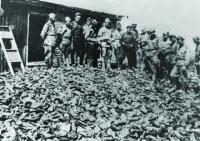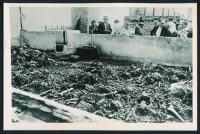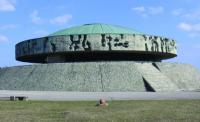THIS WEEK, hardened veterans of the Red Army discovered something that shook even them. For three years they had been fighting the Germans and had seen, and experienced, German brutality. They had seen the atrocities committed against their fellow soldiers, the rape of their women, the executions of their Jewish neighbors and the torture of the Partisans. Nothing prepared them for what they saw this week, 70 years ago at Majdanek.
Majdanek was a German concentration camp located two miles from the 1,400-year-old Polish city of Lublin. Today Lublin has a population of 350,000, making it the ninth largest city in the country and the largest Polish city east of the Vistula River. At the beginning of the war, its population was 122,000, almost half of which was Jewish.
Originally, the camp was established as a labor camp. That changed with the implementation of Aktion Reinhardt, on the order of SS Reichsführer Heinrich Himmler, on October 13, 1941. Aktion Reinhardt was to implement “The Final Solution” to the “Jewish problem,” and was named for the late Reinhard Heydrich, who had been assassinated in Prague.
Subsequently, Majdanek functioned as a sorting and storage depot for property and valuables taken from the victims of other killing centers, but it also murdered as well. It is estimated that, at least, 59,000 were murdered at the camp, which began operation in September 1942. The high water mark occurred on November 3, 1943, when 18,400 Jews were killed on a single day. By May of 1943, Majdanek was using Zyklon-B in its extermination efforts.
With the units of the Third Belorussian Front, commanded by Ivan Chernyakhovsky, rapidly approaching, the camp commandant, SS Obersturmbannhührer Arthur Liebehenschel ordered the camp evacuated and the evidence destroyed. He left that task to his incompetent and lethargic second-in-command, SS Obersturmführer Anton Thernes.
On July 24, 1944, the Red Army stumbled onto Majdanek, which still contained about 1500 inmates. Most of them were Soviet POWs or Polish peasants. The incompetent Thernes and his assistant, SS Hauptsturmführer Wilhelm Gerstenmeier were arrested, with four others. Their trial began on November 27, 1944, before the Special Penal Court in Lublin. On December 2, 1944, they were convicted and sentenced to die. All, except Edmund Pohlmann, who had committed suicide that night, were executed the next day at the prison camp, by hanging.
At the time, no one in the world had any idea that the Germans were killing on an industrial scale. The Soviets published the first story, by war correspondent Konstantin Simonov, in the Red Army newspaper Red Star, on August 10, 1944. Even with the accompanying photos, it was too incredible for most to comprehend. The next day, Soviet photographer Roman Karmen wrote an account of what he had seen, which was translated into English and published in the Daily Worker, the newspaper of the U.S. Communist Party. Most didn’t believe it, thinking that this, like other Soviet stories about German atrocities, was merely more anti-German Soviet propaganda. On August 13, 1944, the Los Angeles Times reprinted the Daily Worker story, but with a disclaimer that the source was Russian and had not been verified by Americans, therefore, inferring that it was not to be trusted. It was not until August 28, when Life Magazine, finally, published the Soviet photos that the American public saw them. Americans began to comprehend the horror of the Nazi regime when the New York Times, finally, published an article by William Lawrence, recounting what he had seen after being allowed to visit the camp. Even then, the British would not publish a story by the BBC’s own Alexander Werth, because, “...they thought it was a Russian propaganda stunt!” But, as Russian-born Werth said, for the Soviets, this discovery was, “...staggering. It brought into sharper focus...the real nature, scope and consequences of the Nazi regime in action.” For two months after the discovery, Simonov published accounts in the “Polish Jewish Observer,” chronicling, “...the wholesale extermination of the Jewish population....”
The camp was initially called Concentration Camp at Lublin. Later it was changed to Prisoner of War Camp at Lublin. In February 1943, its name reverted to Concentration Camp. Its first guests were Soviet POWs. Its first Jewish guests came from Slovakia. They were followed by Jews from the Czech Protectorate. Most of the Jews came from Poland. Unlike at many of the other camps, there was no railroad spur bringing the new guests directly into their new home. Rather, they were disembarked at the main railway station in Lublin and then transported by truck to the camp. The camp’s first Commandant was Karl Otto Koch. He had been Commandant at Buchenwald and had been sent to Majdanek as punishment for nonpayment of taxes. While at Majdanek, he was charged with taking bribes from Jewish prisoners at Buchenwald and ordering the murder of two Buchenwald prisoners. He was convicted and sentenced to death. The sentence was carried out in April 1945.
In August of 1944, the Soviet Union decided to make the Majdanek Camp into a museum. The museum was established in November of that year and became the first such museum. The Soviets also produced the first film about a concentration camp - “Majdanek, Cemetery of Europe.”
After things got settled in that area, the Soviets returned the camp to its original use - only this time, holding members of the Polish Home Army (Armia Krajowa) - the Polish resistance forces. They were considered “enemies of the [new] state.”
There were two more “Majdanek Trials.” The first was also held in Poland over two years, with 95 defendants, seven of whom received the death penalty, one of whom was Liebehenschel. The “Third Majdanek Trial” was held in Düsseldorf, Germany, where 16 defendants were tried, beginning November 26, 1975 and spanning six years. At its conclusion, on June 30, 1981, half were convicted and given sentences ranging from three to 12 years.
NEXT WEEK: NARVA
Mr. Wimbrow writes from Ocean City, Maryland, where he practices law representing those persons accused of criminal and traffic offenses, and those persons who have suffered a personal injury through no fault of their own. Mr. Wimbrow can be contacted at
wimbrowlaw@gmail.com

